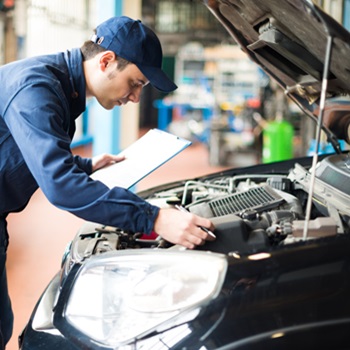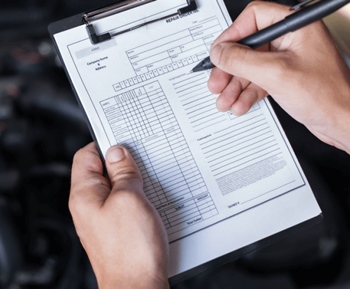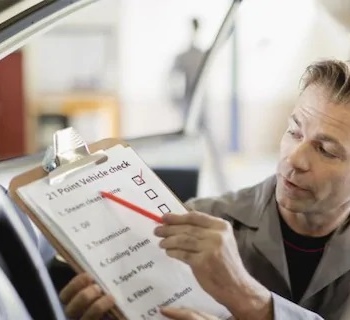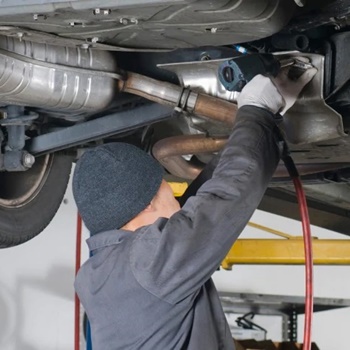Getting your car inspected is not only a thing of bureaucracy. An official inspection of a vehicle takes place every once in a while. Besides filling out the ever so boring paperwork, you need to get your car inspected for safety reasons. A proper car inspection doesn’t take much time, and it will give you the full picture of the car’s condition.
In the following article, I will take you through the finer details of official car inspections, as well as the common and not-so-common mistakes people make before the inspection. This is all routine work, so there is no reason to be worried. After all, if something goes wrong, the inspector will give you a chance to rectify the situation, in most cases. Now, let’s see what car inspections are all about.
What Is a Car Inspection?
 In layman’s terms, an official car inspection involves a series of tests designed to check the essential parts of your car. These tests are conducted by the DMV (or another certified service), and it is usually carried out by a licensed expert, or in some case – experts.
In layman’s terms, an official car inspection involves a series of tests designed to check the essential parts of your car. These tests are conducted by the DMV (or another certified service), and it is usually carried out by a licensed expert, or in some case – experts.
A total car inspection involves testing the vehicle from within, as well as from the outside. So, do not be fooled by the common term “car inspection” – your car will have to pass every test. However, every certified inspector will have their own set of things they focus on. The summary of the test your car has to pass is the same, though.
In short, if your car fails a certain test, the inspector will give you a written explanation which also contains a detailed description of the issue. The inspector also schedules another inspection, this time hopefully with the issues fixed. This report goes to your mechanic or car electrician of choice, and the problem gets mended.
I am aware that all of this sounds more than stressful, but, ultimately, there is no place for panic. Most cars already have everything it takes to pass. Also, car inspection is the moment where regular maintenance pays off. If you cared for your vehicle, you don’t have anything to worry about.
Who Needs to Get Their Car Inspected?
First and foremost, new cars need to be tested. Car manufacturers usually give you a guarantee that the car will pass official inspections. If the vehicle fails, the manufacturer will offer a way to repay you. This usually ends up with them fixing the issue with new parts and specialist repairmen, or they give you a brand-new car. Rarely, the manufacturer will offer you a refund if the problem is too big to solve.
Another group of cars that gets tested often is second-hand cars. Buying a used car doesn’t have to necessarily be a bad thing. But, if you do opt for such a vehicle, getting it tested should be the first order of business. Even if the seller tested the car and got it certified, if the certificate is older than a couple of months, I encourage you to spare some time and money and get the car inspected again!
Additionally, depending on the state you live in, you will probably have to take your car for an inspection to renew your driver’s license. All in all, if you own or drive a car (or both), you will have to get it inspected every once in a while. I would also like to mention that a car inspection may prove useful if you are selling your car. You never know if a problem awaits around the corner. You don’t want to sell a car that is not suitable for traffic, right?
How Often Do You Need to Get Your Car Inspected?
 The only short answer to this question is – it depends. The frequency of mandatory car inspections heavily relies on the state you live in. Additionally, the tests performed during the inspection may differ from state to state. For example, almost every state made the inspection mandatory for new cars, and 2nd hand cars.
The only short answer to this question is – it depends. The frequency of mandatory car inspections heavily relies on the state you live in. Additionally, the tests performed during the inspection may differ from state to state. For example, almost every state made the inspection mandatory for new cars, and 2nd hand cars.
On the other hand, states like Massachusetts require a yearly inspection for all motor vehicles, while Minnesota has no inspection requirements for non-commercial vehicles. You see where I’m getting at? If you want to make sure that you are following your state’s law, call the DMV or visit your state’s governmental website, and get the info. After all, failing to comply with mandatory car inspection will get you in trouble the next time you get pulled over. A lot of states gave the road police the power to require your car to be tested immediately if they find it necessary.
And, let’s be real for a moment here – cars are complex, and a regular driver can’t be sure if something’s wrong with their vehicle. Get your car tested, and ride worry-free.
Inspecting Your Car on Your Own – Is it Possible?
If you are aiming to pass the inspection by proving that the car passed all tests performed by you, I’m afraid I have to disappoint you. Only certified and licensed government officials can give you a pass on a car inspection. Sometimes, the state can outsource the job to a large car tech company, but that all cooks down to the same concept. You just can’t pass these inspections without an official inspector going through your car.
What you can do, on the other hand, is make sure you pass the inspection by fixing your car. For example, using an OBD2 scanner can help you check for issues and diagnose any potential problems you stumble upon. If you have “check X” lights on, you need to get to the bottom of that problem and root it out, even if that means taking the car to a mechanic or electrician. Luckily, cars of today have intricate diagnostic systems and onboard computers that can help you out as well.
When it comes to the outside of your vehicle, there is a series of tests you can do. Check the tires, the windshield wipers, all the lights, and of course the mirrors. These are all car parts that play an integral role in your safety on the road.
Car Inspection – What Kind of Tests to Expect?
 By now, you are surely wondering “which tests are involved in a regular car inspection?”. Because every car inspector has their own special requirements, next to the mandatory ones, no one can say what will be the main focus of the inspection. However, I am going to take you through various tests, some common some less so. Let’s dig in.
By now, you are surely wondering “which tests are involved in a regular car inspection?”. Because every car inspector has their own special requirements, next to the mandatory ones, no one can say what will be the main focus of the inspection. However, I am going to take you through various tests, some common some less so. Let’s dig in.
1. The Common Tests
When I say “common tests” I mean tests that every inspector conducts. Car inspections involve a series of common tests that we can divide into two main groups: interior and exterior.
1.1. Common interior car inspection tests
When it comes to the interior tests, you can expect:
- Brake test – brake and handbrake are essential when it comes to safety and maneuvering. Make sure to have a fresh batch of brake fluid in the system, and that everything works correctly. The inspector may also test the brakes during the drive test.
- Gear shift test – this goes out to manual shift owners. If your car has a clutch and a manual stick, the inspector will test them.
- Seat belts – yes, a car inspector needs to check if the seatbelts work correctly. This includes the seatbelts on the back seat as well.
- Dashboard and signalization – this part of the inspection is becoming less common because the on-board computer does the work for us. Some inspectors like to give the dashboard a double-check. Make sure that you fixed all the issues beforehand, and that no “check X” light is on.
- Horn test – The horn is an important part of the “vehicle language”. It helps us communicate our intentions to the other traffic participants.
1.2. Common exterior car inspection tests
The exterior tests are important as well, even though they include less-thought-of parts. Here’s what to expect:
- Taillight test – all the lights and signalization must work flawlessly, as they enable you to communicate with your surroundings.
- Turn light test – similar to other signal lights on the tail of your car, the turn lights must also work perfectly.
- Headlights – high and low beams must work well. Some inspectors even test the fog lights. You can always get a fresh pair of LED headlights or a headlight restoration kit. Just make sure that your new LEDs are not too bright for the road.
- Windshield wipers – believe it or not, a lot of people make the mistake of disregarding the wipers as non-important. Every inspector will test the wipers since they enable the driver to see in bad weather.
- Tires – you would be surprised by how many cars fail the inspection because the tires are either too worn or entirely wrong for the given climate. The safest bet is to get a set of all-season tires.
2. The Not-so-Common Tests
If you are really down on your luck, you will get an inspector that likes to take it a tad bit too far. Now, I’m not saying that this is necessarily a bad thing, but sometimes the tests may prove more tedious than actually useful.
One of the less common tests is the strength of the headlight. The inspector can test the lumen and lux of your headlight set if they deem that the lights are too bright. Every state has its own regulations, but this should not be a big deal, since you can always go back to a halogen headlight set if the situation gets tight. Halogens are the weakest among modern headlights, and almost every set is within the legal range.
A lot of inspectors will ask you to install license plate lights if your car doesn’t have any. While it is not mandatory in a lot of states, license plate lights are important for vehicle identification.
Another thing that an inspector may ask you to change is the dimmed or tinted windows. Believe it or not, there are strict regulations regarding window tints in almost every state. This issue, however, is solved rather easily.
If you work in a specific industry that requires specific first aid sets AND you use the car for work, an inspector may check the contents of the kit. OSHA requires people to have specific first aid kits if they work in an industry that involves hazardous situations.
3. Drive Test
After the inspection is done, the inspector may take your car for a short ride. Also known as the road test, this is the best way to actively test all the parts and essential features a car must have working properly. The driving test is usually the longest part of the car inspection.
The inspector tests the engine and its consistency in providing power. This is also the perfect opportunity to see if the dashboard is reporting correct information and if all the features around the steering wheel work well. Signal lights, turn lights, headlights, the horn, etc. – this is all tested during the road test.
4. Emission Test
Lastly, we have the environmental part of the car inspection. The emission tests are gaining traction lately, especially since the world eco-organizations are trying to cut down the green-gas emission globally. This is where the states’ laws may seem a little too strict, but there is no going around it.
For example, the state of California has very harsh laws when it comes to gas emissions, so be extra vigilant while preparing your car for the inspection. Older vehicles undergo detailed emission tests because they are notorious for going over the legal limit.
So, How Long Does It Take to Get Your Car Inspected?
 If you bring the necessary papers*, the first part of the test, including the inspection should not last longer than an hour. More experienced inspectors may do this way faster, but never under 15 minutes. The road test should take somewhere between 30 and 90 minutes, depending on all sorts of various factors in play.
If you bring the necessary papers*, the first part of the test, including the inspection should not last longer than an hour. More experienced inspectors may do this way faster, but never under 15 minutes. The road test should take somewhere between 30 and 90 minutes, depending on all sorts of various factors in play.
The emission test takes less time, depending on the gear used to measure gas emissions. At least 10 minutes pass from the beginning to the end
Lastly, the certification takes a few minutes. You get a “passed inspection tests” which you can use to renew your license, register or sell your car.
All in all, if you get there on time, the whole ordeal can last from 45 minutes to a couple of hours. Various factors are at play here – vehicle size, road conditions, manual/automatic, previous issues, new issues, and much, much more.
Final Thought
Car inspections don’t look so scary anymore now, right? The number of vehicles on the road is increasing, and these standardized tests help all of us, including the people that don’t even drive. Just imagine the world where we don’t take our cars to get properly inspected and licensed.
Keeping your 4-wheeled friend in a healthy condition is safer for you, other people in traffic, and the environment. And, above all, these inspections help you keep your car well-maintained, which always translates to spending less money on repairs and spare parts. Now, go ahead and get your car inspected!